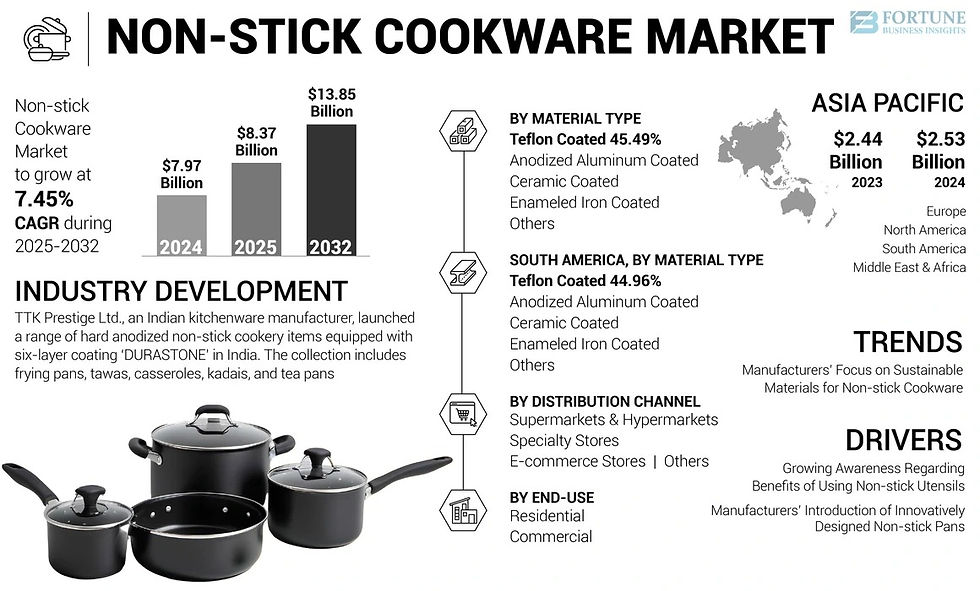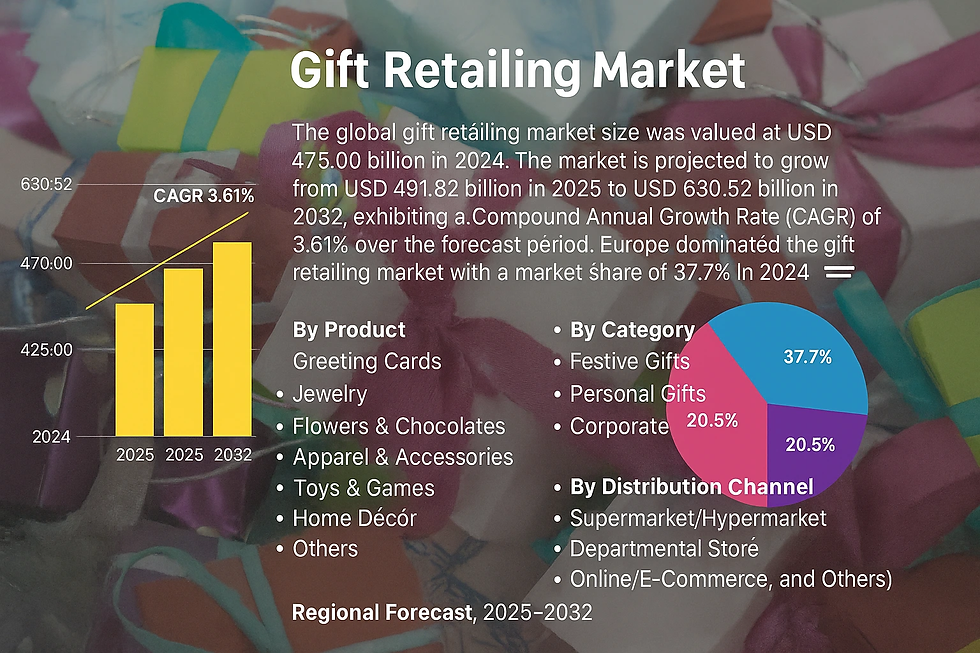Air Fryer Market Regulatory Framework and Compliance Outlook 2032
- James Figo
- 4 hours ago
- 3 min read
According to Fortune Business Insights, the global air fryer market size was valued at USD 8.07 billion in 2024 and is projected to grow from USD 9.40 billion in 2025 to USD 17.71 billion by 2032, exhibiting a CAGR of 9.47% during the forecast period. The market is witnessing robust growth driven by the rising demand for oil-free cooking appliances, smart kitchen adoption, and social media-driven recipe trends.
Asia Pacific dominated the market in 2024 with a 46.22% market share, led by high demand in China, India, Japan, and South Korea. Digital air fryers accounted for the largest segment, while basket-style models remained the most popular choice among global consumers.

Request FREE Sample PDF Copy of Air Fryer Market: https://www.fortunebusinessinsights.com/enquiry/request-sample-pdf/air-fryer-market-107276
Key Companies Profiled
Groupe SEB (France)
Midea Group (China)
Koninklijke Philips N.V. (Netherlands)
Xiaomi Corporation (China)
Spectrum Brands, Inc. (U.S.)
Faber S.p.A. (Italy)
Conair Corporation (U.S.)
Meyer Corporation (U.S.)
TTK Prestige Ltd. (India)
NuWave, LLC. (U.S.)
Air Fryer Market Trends
Asia Pacific witnessed air fryer market growth from USD 2.96 Billion in 2023 to USD 3.73 Billion in 2024.
Surge in Vegan & Plant-Based Cooking
Health-conscious consumers are increasingly using air fryers to prepare vegan and plant-based meals, further supported by influencer-led promotions.
Eco-Friendly & Energy-Efficient Designs
Manufacturers are introducing models with low energy consumption and sustainable materials to meet eco-conscious consumer demand.
Multi-Purpose Cooking Appliances
Growing demand for appliances that bake, roast, grill, and fry in a single unit is reshaping product innovation.
Growth Drivers
Shift Toward Healthy & Oil-Free Cooking – Growing awareness about low-fat diets is boosting adoption across households and foodservice facilities.
Smart Kitchen Integration – Digital air fryers with app connectivity, voice control, and multi-functionality are gaining traction.
Social Media Influence – Recipe-sharing platforms like Facebook, Instagram, and WeChat are accelerating consumer awareness.
Urban Lifestyle & Nuclear Families – Rising number of small households prefer compact 3–5 liter models for daily cooking.
Challenges & Restraints
High Product Cost – Premium smart models remain expensive for price-sensitive consumers.
Availability of Alternatives – Ovens, microwaves, and traditional cookware limit air fryer penetration.
Short Product Lifecycle – Rapid tech advancements make some models obsolete faster.
Segmentation Analysis
By Type
Digital Air Fryers – Largest share due to multifunctionality, smart controls, and preset programs.
Manual Air Fryers – Affordable and simple to operate, catering to budget-conscious buyers.
By Model Type
Basket Style Models – Fastest-growing segment due to affordability and ease of shaking food for even cooking.
Countertop Models – Preferred by small households for space efficiency.
Multi-Cooker Models – Popular in hospitality for versatility.
Toaster Oven Models – Favored for large-volume cooking.
By Capacity
3–5 Liters – Largest segment (42.91% share in 2024) ideal for nuclear families.
Up to 3 Liters – Growing demand from single-person households and mobile living spaces.
5–6 Liters & above 6 Liters – Popular in restaurants and catering services.
By Distribution Channel
Supermarkets & Hypermarkets – Leading sales channel due to product variety and availability.
Online Channels – Fastest-growing due to convenience and exclusive digital discounts.
Specialty Stores – Preferred for premium products with after-sales support.
By End-User
Households – Dominant segment, driven by preference for oil-free cooking.
Foodservice Facilities – Demand for large-capacity models in commercial kitchens.
Regional Insights
Asia Pacific – USD 3.73 billion in 2024; strong demand for digital, compact models in China, India, Japan, South Korea.
North America – Growth fueled by DIY cooking trends and adoption in hotel chains.
Europe – Increasing shift to energy-efficient and oil-free cooking.
South America & Middle East – Rising e-commerce appliance sales in Brazil, UAE, and Saudi Arabia.
Read Full Research Report: https://www.fortunebusinessinsights.com/air-fryer-market-107276
Competitive Landscape
Leading players such as Groupe SEB, Midea Group, and Koninklijke Philips N.V. are focusing on:
Smart technology integration (app-based controls, voice assistance).
Expanding into eco-friendly product lines.
Strategic partnerships with retailers in emerging markets.
Recent Launch: In April 2024, Philips introduced the Signature Series Airfryer HD9867/90 with rapid air and fat removal technologies, targeting the premium segment in India.
KEY INDUSTRY DEVELOPMENTS
January 2024: Versuni, a Koninklijke Philips NV-owned small appliances manufacturing company, opened its second 25,000-square-meter factory in Ahmedabad, India. The factory has an annual production capacity of 500,000 air fryers, 200,000 garment steamers, and hand mixers in India.
June 2023: Versuni, a Koninklijke Philips N.V.-owned small appliances manufacturing company, established a partnership with SAP SE, a European software company, to utilize the SAP Sustainability Control Tower to monitor the recycling process of used air fryers in Sao Paulo, Brazil.
The air fryer market is set for strong growth as consumers continue shifting towards health-conscious, smart cooking solutions. Innovations in multi-functional, eco-friendly, and app-connected models will be critical for capturing market share, especially in emerging economies.












Comments